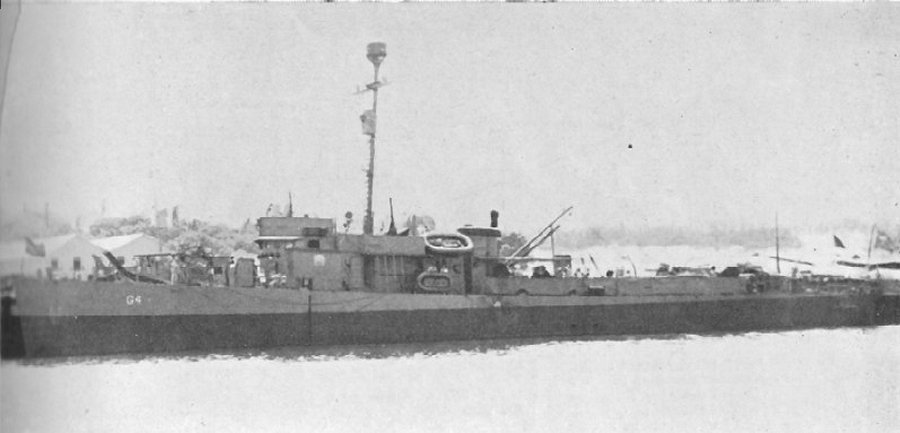BRAZILIAN NAVY NORTHEAST NAVAL FORCE *
1)SUB CHASER GOIANA G6

Sub Chaser Goiana ex PC 554 Photo by Robert Hurst. http://www.navsource.org/archives/12/1201055402.jpg
Built 1942
Incorporated 29 Oct 1943
Decommissioned 21 Dec 1949
Tonnage 295 t / 450 t. full loaded
Length: 52.73 m
Beam: 7.01 m
Draught 3.04 m.
Propulsion: Diesel; 2 Engines 16 Cylinders; General Motors Model 16-258S gearing 2.000 bhp, 2 shafts with 3 blade propellers.
Armament: 1 3 pol. (76.2 mm/50) Oerlikon gun; 1 Bofors L/60 gun, 40 mm in one single mounting Mk 3; 2 machineguns Oerlikon 20 mm single mountings Mk 4; 2 grenade octuples throwers of A/S (LBG) 7.2 pol. Mousetrap Mk 20 at the bow ; 2 Depth Charges rack Mk 3 and 2 side throwers type K Mk 6 for Depth Charges Mk 6 or Mk 9.
Speed: max. 20 knots.
Range: 3.000 Nautical miles @12 knots.
Class G submarine Chaser (ex USS PATROL-CRAFT 554), sixth in a series of eight (Guaporé, Gurupi, Guaíba, Gurupá, Guajará, Grajaú and Graúna), whose keel was laid at the Sullivan Dry Dock & Repair Corp. , Brooklyn, New York, United States on December 20, 1941, launched on May 2, 1942 and incorporated into the US Navy on September 2, 1942. The ship was assigned to Brazil after agreements between the Brazilian Government and the American government, being received at the Sub-Chassing Training Center of Miami on October 29, 1943.
It was equipped with two General Motors diesel engines, model 16-258-S, 16 cylinders in “V”, four stroke, with a total power of 3,600HP, transmitted to two bronze propellers of three blades with 80 inches in diameter; two Sperry electro-mechanical rudders maneuvered from the bridge and gyroscopic needle compartment; medium pressure vaporizer with a capacity of 2,800 liters / hour; two Worthington Pump Co. air compressors, 600 pounds / inch;auxiliary boiler, 80 pounds / inch using naphtha as fuel; 20 knots maximum speed. Electricity was supplied by two dynamos powered by a diesel engine, two-stroke, model 6-71, direct current, 120 volts, 60KW, 500 amps.
For radio communication the ship had a Mod. TCE transmitter from Westinghouse Electric Comp. with maximum power of 100 watts in telegraphy and 40 watts in phone, continuous and modulated waves with a frequency of 350 to 9050 Kcls. A receiver model R-A-0-2, from Westinghouse Electric Comp. for reception in the bands of 540 to 30,000 kcs, a receiver model R.B.O of E.H.Scott Radio for reception of broadcasting in the bands of 540 to 15,600 kcs, which can be used in emergency for telegraphy or telephony. For visual communication the ship had a flag post with 8 halyards on the mast, Scott equipment on the mast lintel, two 12 ’’ signal spotlights, 1000 watt lamp, two portable signal lamps.
For indoor communications it has a network with 10 self-excited system telephones and a network of acoustic tubes. For navigation on the ship he had a gyroscopic needle, patent Sperry, mark XVI with seven repeaters, a magnetic needle on the bridge, a longboat needle, a echo sounder model N-J-8, Bludworth brand for soundings in feet or arms up to 300 fathoms and a radiogoniometer for frequency of 240 to 2,000 kcs. As for the defense against magnetic mines, the ship had a Degaussing apparatus. For underwater listening service, a QCT device, Submarine Signal Comp. for listening to noise and determining distance up to 5000 yards and echo marking.
As radar equipment he had a Western Eletric device. Comp. type CW-43 ABN for surface target detection. Their crewmembers became known as “iron fighters” for having steel hulls as opposed to “wooden fighters”, with wooden hulls (“J” class). Class “G” ships reached seven knots in 30 seconds and were more comfortable than class “J”, as they had accommodation, kitchen, piazza d'armas, compatible with a normal internal ship routine, but which also they demanded physical resistance from the crew, especially when escorting convoys between Trinidad and Recife (PE).
During war period SC Goiana escorted 28 convoys along the Brazilian coast.
Complement: 65
Select nao autorizado. You have an error in your SQL syntax; check the manual that corresponds to your MySQL server version for the right syntax to use near 'and a.id <> 177 order by ordem asc' at line 1